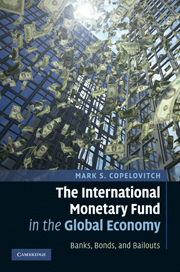Book contents
- Frontmatter
- Contents
- List of figures
- List of tables
- Preface
- 1 The International Monetary Fund in the global economy
- 2 Global finance and the politics of IMF lending: theory
- 3 Global finance and the politics of IMF lending: evidence
- 4 Global finance and IMF lending to Mexico, 1983–1995
- 5 Global finance and IMF lending to South Korea, 1983–1997
- 6 Conclusions
- Appendices
- References
- Index
1 - The International Monetary Fund in the global economy
Published online by Cambridge University Press: 06 July 2010
- Frontmatter
- Contents
- List of figures
- List of tables
- Preface
- 1 The International Monetary Fund in the global economy
- 2 Global finance and the politics of IMF lending: theory
- 3 Global finance and the politics of IMF lending: evidence
- 4 Global finance and IMF lending to Mexico, 1983–1995
- 5 Global finance and IMF lending to South Korea, 1983–1997
- 6 Conclusions
- Appendices
- References
- Index
Summary
Introduction
This is a book about the impact of globalization on international politics. To be more specific, it is a book about the connection between changes in the composition of international capital flows and changes in the politics and policymaking of the International Monetary Fund (IMF, or Fund), the central institution of global financial governance. Financial globalization – the explosive growth in the size, depth, and complexity of international markets – is the defining characteristic of the contemporary world economy. Indeed, international financial integration today has reached (and in many ways surpassed) levels not seen since the “first globalization,” in the era prior to World War I (WWI). Over the last three decades private international capital flows to developing countries have grown exponentially, from nearly zero in 1970 to $491 billion in 2005. Daily foreign exchange trading has increased from $850 billion in 1986 to $3.2 trillion in 2007. In the first quarter of 2007 commercial banks reported $25 trillion in total foreign claims, up from $17 trillion in 2005. At the same time, international investors held over $20 trillion in sovereign and private bonds, with net issuance increasing at a rate of 18 percent per year.
Unfortunately, as starkly illustrated by both the current global crisis and the major upheavals of the 1980s and 1990s, this resurgence of financial globalization has been accompanied by a corresponding increase in the frequency and severity of financial crises.
- Type
- Chapter
- Information
- The International Monetary Fund in the Global EconomyBanks, Bonds, and Bailouts, pp. 1 - 28Publisher: Cambridge University PressPrint publication year: 2010
- 1
- Cited by



